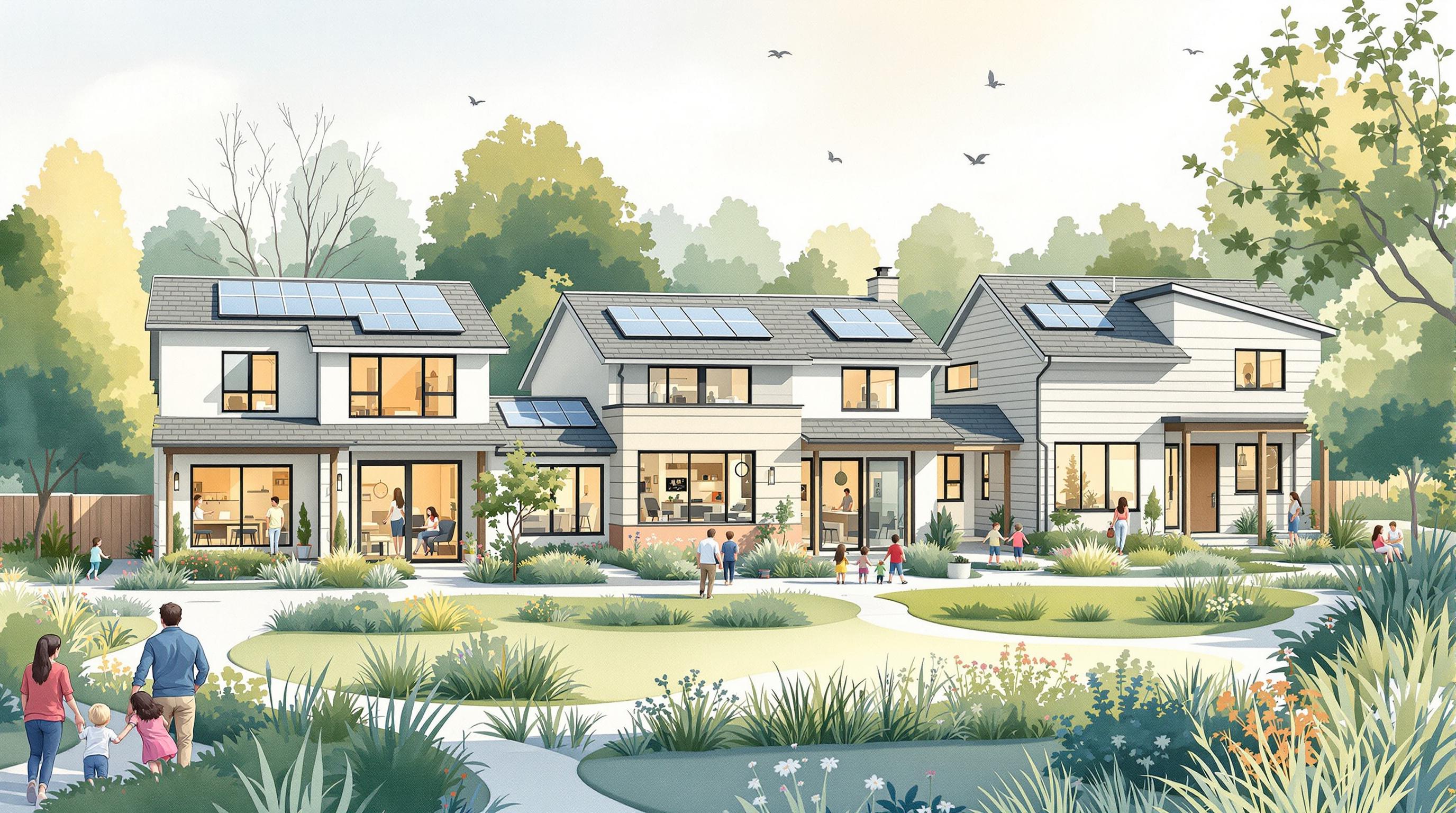-
Key Benefits:
- Farmers receive payments averaging $690 per acre.
- Easements lower land costs by 30-40%, making farming more affordable.
- Protected farms reduce runoff by 82% and retain 8-15% more organic matter.
-
Organizations Involved:
- Agricultural Preserve Board (APB): Focuses on permanent easements and soil conservation.
- Lancaster Farmland Trust: Improves water quality and reduces pollution by 8,400 pounds annually.
-
Eligibility:
- Farms need 50+ acres (or 10+ acres if near preserved land) with productive soils (Class I-IV).
- Owners must follow conservation plans and keep land in active farming.
-
Impact:
- Supports Lancaster's $4 billion agriculture industry and 60,000 jobs.
- Prevents 30 million liters of urban runoff annually.
Lancaster County’s preservation efforts combine public and private funding to sustain farming, protect the environment, and support local economies.
Protecting Farmland 101: Easement Insurance and Enforcement
Main Preservation Programs
Lancaster County's success in farmland preservation is driven by two key organizations working together to protect its agricultural land. While their methods differ, both share the goal of safeguarding the county's farming heritage.
Lancaster County Agricultural Preserve Board (APB)

The Agricultural Preserve Board (APB) plays a crucial role in conserving farmland through a focused conservation strategy. Using conservation easements, the APB ensures that farms remain productive. To maintain this, annual inspections confirm ongoing agricultural use. This approach has led to impressive results: farms under APB protection experience soil erosion rates of less than 0.5 tons per acre each year, compared to the 3-5 tons typically lost on unprotected farmland [4].
Lancaster Farmland Trust

Adding to public efforts, the Lancaster Farmland Trust uses cost-share partnerships to protect land while promoting environmental care.
One standout feature of their work is improving water quality. By implementing tailored farm plans, the Trust helps reduce nutrient pollution by 8,400 pounds annually, aligning with environmental goals outlined in their programs [1].
| Program Feature | APB | Lancaster Farmland Trust |
|---|---|---|
| Funding Source | County funds with state matching | Private donations and public grants |
| Special Focus | Permanent easements with farming checks | Water quality improvement through tailored plans |
Program Requirements
Land and Soil Standards
Farmland must meet strict criteria to qualify for preservation, focusing on agricultural productivity and protecting against development. The Land Evaluation and Site Assessment (LESA) system is used to evaluate eligibility, weighing soil productivity (50%), development pressure (30%), and farm viability (20%). To qualify, properties generally need 50+ acres of Class I-IV soils, although parcels as small as 10+ acres can be eligible if they border already-preserved farms. This exception allowed 17 small Amish vegetable farms in Leacock Township to secure protected status [1][6].
These standards are designed to keep Lancaster's farmland productive while limiting urban expansion.
| Requirement Type | Standard | Notes |
|---|---|---|
| Minimum Acreage | 50 acres | 10+ acres if adjacent to preserved farms |
| Soil Classification | Class I-IV | Prime agricultural soils |
Property Requirements
Applicants must own the property for at least 12 consecutive months before applying [6]. Additional restrictions include:
- A maximum of 2 acres can be used for non-agricultural buildings [1][6].
- The land must remain in active farming.
- Owners are required to follow a state-approved conservation plan, either:
- An Agricultural Erosion and Sedimentation Plan
- A Full Conservation Plan
For example, the 180-acre Beiler farm was prioritized for preservation due to its high-quality soils and location near development zones [7][6]. Properties with historical significance, like the 18th-century Baer homestead, may also qualify through special funding [7][6].
Program Advantages
Money-Saving Options
Lancaster's preservation programs are designed to deliver real financial benefits alongside meeting conservation goals. These programs provide direct savings through conservation easement payments and tax reductions. For instance, the Lancaster Farmland Trust preserves land at a cost of $1,107 per acre while securing $3.5 million in private funding matches [1].
Farmers participating in these programs also gain access to valuable resources through public-private partnerships. Typical conservation planning costs, which average $33,000 per farm, are covered. Additionally, preserved farms enjoy several benefits:
| Benefit | Impact |
|---|---|
| Easement Payments | Average of $690 per acre |
| Tax Reductions | Lower annual tax burden |
| EQIP Access | Funding for infrastructure |
| Planning Support | Full coverage for CNMP |
Land Protection Results
These programs not only provide financial advantages but also deliver measurable environmental outcomes. Farms under protection have implemented 13 new Comprehensive Nutrient Management Plans, improving water quality across 1,941 preserved acres [1].
The economic impact is substantial, supporting Lancaster's $4 billion agricultural industry and over 60,000 jobs tied to farming [4]. Environmentally, preserved farms outperform others, with soils retaining 8-15% more organic matter [4]. Additionally, the Trust's initiatives prevent 30 million liters of urban runoff annually [1], contributing to better water management and healthier soils.
A key aspect of these programs is their role in farm succession planning. Out of 25 recently preserved farms, 16 have completed succession plans through comprehensive management support [1]. This combination of economic and ecological focus ensures Lancaster's agricultural landscapes remain productive and sustainable for future generations.
sbb-itb-7fa5722
Application Steps
Getting Started
To apply for preservation, you'll need three essential documents:
- Property tax identification
- Current conservation plan
- Farm assessment documentation
For help with erosion plans or to get a Farmland Trust assessment (completed within 45 days), reach out to Jason Reuter at 717-874-2561 [3].
Here are the initial costs you can expect:
| Requirement | Cost Range |
|---|---|
| Appraisal | $3,500-$5,200 |
| Survey | $1,800-$2,500 |
While these are upfront expenses, they can be offset through EQIP's reimbursement program, which covers up to 75% of the costs for conservation practices [9].
Application Timeline
Most applications take between 9 and 14 months to process. However, ARPA-funded projects can be completed in just 6 months when using pre-approved appraisers [1]. This faster timeline is especially beneficial for areas like the Route 896 corridor, where development pressure threatens prime agricultural land.
For example, a 98-acre dairy farm in Strasburg recently scored 287 out of 300 points, showcasing its high agricultural value and strategic importance for preservation [1].
The Block Preservation Initiative provides an additional 15% ranking score boost for parcels that help form preservation blocks larger than 200 acres. This strategy has already proven successful. A recent project near Lititz preserved three neighboring farms, totaling 214 acres [1][4].
Common Application Issues
Applications are sometimes rejected due to:
To avoid delays, ensure your conservation plan is executed within 18 months of approval [1].
Local Success Stories
Applying the right strategies can lead to real-world results, as shown by these examples from Lancaster County:
Preserved farms have made strides in reducing pollution. Participating operations cut nitrogen runoff by 57% and phosphorus by 62% by upgrading manure systems and adding riparian buffers [4]. These improvements came from investments in key infrastructure, such as:
- Manure storage facilities
- Riparian buffers
- Stream bank protection
One family-run dairy farm used easement funds to install a methane digester while planning for the next generation's involvement. This approach tackled both succession planning and emissions reduction [2][4].
An equine business diversified by offering educational tours, bringing in $45,000 annually while continuing hay production [4].
In a great example of collaboration, Lancaster Farmland Trust teamed up with NRCS to help farms adopt conservation practices. This was made possible by combining preservation efforts with EQIP funding [3][5].
Recent preservation projects have also shown success in reducing sediment runoff by 82%, thanks to barnyard runoff controls and other best practices [1][3]. These results align perfectly with the programs' goals of keeping agriculture thriving while protecting the environment.
Help and Information
Once landowners understand the application requirements, they can tap into these helpful resources:
Central PA Realty

Central PA Realty focuses on agricultural property transactions, particularly those involving preservation. Their offerings include:
- Immediate cash offers for farmland ready for preservation
- Skilled negotiation of preservation easement terms
- Tailored strategies for preservation planning
Local Support Organizations
The Lancaster County Agricultural Preserve Board is the main point of contact for preservation applications. Their office is located at 150 N. Queen St., Suite 325, and they can be reached at (717) 299-8355.
Here are some other key organizations and what they offer:
| Organization | Service Provided | Contact |
|---|---|---|
| Lancaster Farmland Trust | LESA reviews and vendor network | (717) 687-8484 |
| Conservation District | Plan approvals and technical support | (717) 299-5361 ext.5 |
| Lancaster Farm Science Center | Monthly preservation workshops | (717) 392-4911 |
Additionally, the Ag Plan Reimbursement Program helps cover 75% of conservation planning costs (up to $500) through PACD grants. Reimbursement requests should be directed to Jason Reuter.
The Lancaster Farmland Trust also offers assistance by connecting landowners with experienced surveyors and appraisers.
Preserving Lancaster's Farms
Lancaster County has shown how partnerships can lead to real benefits for both the environment and the economy. The county's agricultural sector plays a big role, especially in agritourism, which brings in $82 million annually [4]. What's more, preserving farmland is far less expensive than urban development, which costs about $15,000 per acre [4].
The environmental benefits of these preservation efforts are just as impressive. Protected farms deliver:
| Achievement | Impact |
|---|---|
| Stormwater Management | 63% better performance than developed land [4] |
| Carbon Capture | 12 tons per acre each year [4] |
| Farm Affordability | 30-40% lower land costs [2] |
These programs enforce strict soil and conservation standards, ensuring long-term sustainability. They also make it easier for young farmers to get started, as conservation easements reduce land costs by 30-40% by eliminating development rights [2]. This creates more opportunities for new farmers to thrive.
"Every $1 invested in preservation generates $7 in ecosystem services", says USDA NRCS specialists, emphasizing the broader value of these initiatives [9][10].
With $2.18 million set aside for 2025 projects, Lancaster is not only protecting its highly productive soils but also improving flood resilience by maintaining waterways with buffer strips [1][2][4].
FAQs
What is a preserved farm in PA?
A preserved farm in Pennsylvania is a property safeguarded by permanent agricultural conservation easements. These easements ensure the land stays dedicated to farming for generations to come. In Lancaster County, preserved farms must meet specific standards, including:
| Requirement | Details |
|---|---|
| Soil Quality | Classified as Prime or Statewide Important [11] |
| Active Agricultural Use | Must have ongoing farming operations [11] |
| Conservation Standards | Follow USDA-approved conservation plans [11] |
These criteria align with the LESA system outlined in the Program Requirements. Farms under this program must adhere to USDA-approved conservation plans, which are reviewed annually for compliance. While development rights are restricted, farm owners retain the ability to farm or sell the property. Any exceptions, such as emergencies, require court approval and come with a 200% penalty fee [6][8].



